 I was reading a fascinating article on an architect named Yousef Al-Mehdari who has ideas about a unique style in architecture using the patterns of human movement.
I was reading a fascinating article on an architect named Yousef Al-Mehdari who has ideas about a unique style in architecture using the patterns of human movement."Al-Mehdari suggests that a careful – even mathematically exact – study of human bodily movement could serve as a basis for generating new types of architectural form."
The full article can be seen here.
An exhibit of Yousef's works is on display this month in London, details here.
A quote in the article referencing this architectural style from a novel by Jeff VanderMeer really struck my interest..
"Where the sculptures of saints would have been set into the walls, there were instead bodies laid into clear capsules, the white, white skin glistening in the light – row upon row of bodies in the walls, the proliferation of walls. The columns, which rose and arched in bunches of five or six together, were not true columns, but instead highways for blood and other substances: giant red, green, blue, and clear tubes that coursed through the cathedral like arteries. Above, shot through with track lighting from behind, what at first resembled stained-glass windows showing some abstract scene were revealed as clear glass within which organs had been stored: yellow livers, red hearts, pale arms, white eyeballs, rosaries of nerves disembodied from their host."
I checked out the Amazon link related to Jeff VanderMeer's first novel, "Veniss Underground" and found the following plot description very intriguing..
"In his masterful first novel, VanderMeer (City of Saints & Madmen) sets a dark, phantasmagoric tale in and beneath a decadent, far-future city where Living Artists craft monstrous works of biological art and genetically enhanced meerkats plot to make humanity obsolete. The story is told from three viewpoints, that of Nicholas, a Living Artist not quite talented enough to succeed; his more pragmatic, vat-grown twin sister, Nicola; and her former lover, the unsavory Shadrach, who has survived a childhood lived in the dangerous levels beneath the city and now operates above ground as an agent for Quin, the world's greatest Living Artist and the perverted master of much that is evil within the city of Veniss. When Nicholas's apartment is robbed and the tools of his trade are stolen, he goes to Shadrach and begs an introduction to Quin, hoping to find employment and resurrect his near moribund career. Alas, he fails to follow Shadrach's directions and soon disappears beneath the city, where he undergoes a wonder-filled journey that echoes Dante's Divine Comedy, the myth of Orpheus and Eurydice and the landscapes of Hieronymus Bosch, while also paying homage to the work of such genre masters as Cordwainer Smith and Edward Whittemore. VanderMeer's eye for just the right gruesome detail brings his nightmarish landscapes and bizarre, partially human creatures alive in astonishing profusion. Not for the faint of heart, the story packs a strong emotional wallop."
Anyway, I thought this would interest some of you.




6 comments:
A fascinating post, Aeron - thanks! Hadn't heard of VanderMeer before. Sounds very intriguing.
I have some difficulties with Al-Mehdari's work. The 3d-prints admittedly look great, the way they're lit and photographed, but when you look at the actual 3D imagery it looses alot of it's appeal and looks like fairly generic Poser-puppets crammed together with Giger-like ornaments. The whole "using the patterns of human movement" seems more like conceptal spice to make it more interesting to art theoreticians than any meaningful aesthetic basis for the work. After all, shouldn't all architecture in some way relate to the human body and it's movement in space? Dunno, maybe I'm just not getting it.
Anyway, this sounds more critcal than I meant it to. As I said those 3D prints look amazing.
I really like any architecture with that sort of shapes, it has a wonderful effect on you and I can only dream of what it would be to live in spaces like that.
I'll get that book someday.
I see what you mean, Fufu. It's obvious but something I didn't take into consideration in the concept of designing new architecture around human movement. Everything man builds is already specified to our unique mobilities. It seems mankind has a fascination with squares and rectangles. I wonder if insects had taken over mammals in the evolutionary void left by the dinosaurs, what would their ideal living space be were they to have evolved capable to shape the world around them as we have? I'm sure bee hives, ant caves and termite hills are a good point of reference.
I think Squares and rectangles function best, but maximum function should sometimes be sacrificed for something that could be really moving and special.
By coincidence, I was on google images looking for Alfred Kubin, and stumbled on Vandermeer's blog.
- He had done a couple of posts on Kubin.
http://www.jeffvandermeer.com/tags/read/fiction/
I had thought, reading your post, that Vandermeer sounded a bit like China Mieville, and I see that Vandermeer has interviewed Mieville, and that Mieville says that Kubin's novel "The Other Side"
was an influence on his novel "The City in the City"
Paul Rumsey.
good post!
Post a Comment